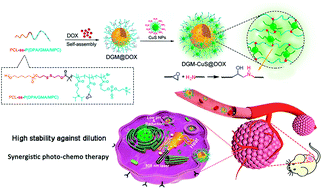Using copper sulfide nanoparticles as cross-linkers of tumor microenvironment responsive polymer micelles for cancer synergistic photo-chemotherapy†
Abstract
Photo-chemotherapy presents promising therapeutic effects in cancer treatment. Photo-thermal and chemotherapeutic agents are generally delivered independently or jointly by drug carriers, such as polymer micelles. A polymer micelle is one type of widely researched drug carrier. However, there is a disassembly risk for polymer micelles under excessive dilution in blood circulation, leading to the premature release of payloads from the micelles and finally resulting in undesirable toxic side effects. Herein, amino-PEG decorated copper sulfide nanoparticles (CuS NPs) with photothermal effect were applied as a cross-linker to enhance polymeric micelles' stability and to provide photothermal therapy in the meanwhile. The micelles were prepared using a pH/reductive responsive polymer, poly(ε-caprolactone)-ss-poly(2-(diisopropylamino)ethyl methacrylate/glycidyl methacrylate/2-methylacrylloxyethyl phosphorylcholine (PCL-SS-P(DPA/GMA/MP)), abbreviated as DGM. Cross-linked micelles (DGM-CuS) exhibited high photothermal transformation efficiency and excellent stability against dilution, as well as pH and redox responsive drug release. Under near-infrared laser irradiation, the cell cytotoxicity of doxorubicin-loaded micelles DGM-CuS@DOX and DGM-CuS@DOX-P (DGM-CuS@DOX modified by peptides) increased by 17.1 times and 69.2 times correspondingly compared to that without laser irradiation. All of the solid 4T1 tumors disappeared, and tumor metastases were merely observed in the major organs of the tumor-bearing mice after administration of DGM-CuS@DOX and DGM-CuS@DOX-P with irradiation. In this synergistic therapy system, CuS NPs play double roles of a photothermal agent and a micelle cross-linker. The strategy of utilizing nanoparticles as cross-linkers is newly reported, which offers new insight for combination therapy.



 Please wait while we load your content...
Please wait while we load your content...